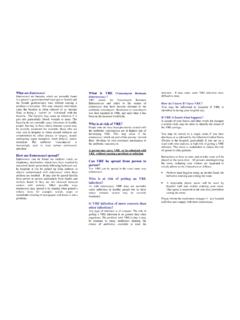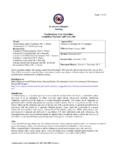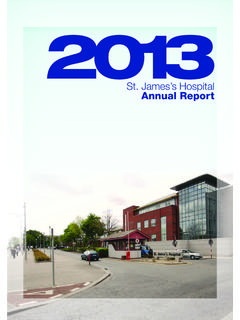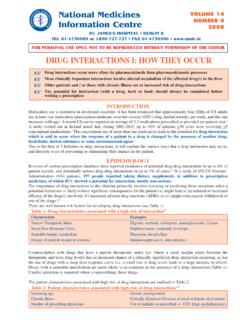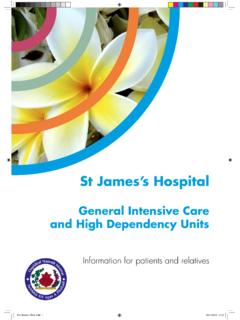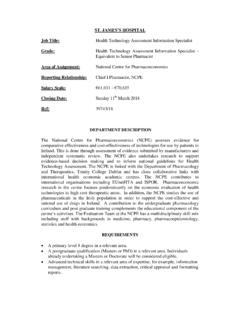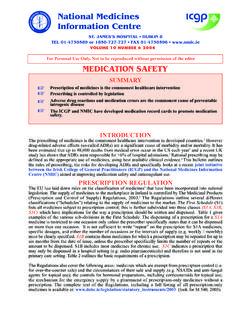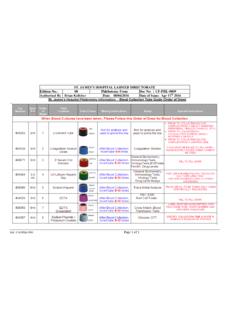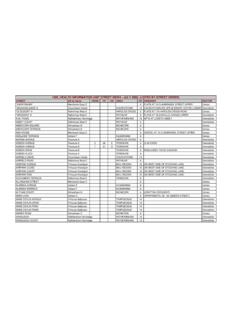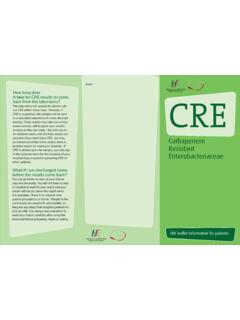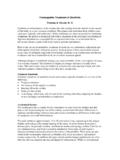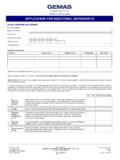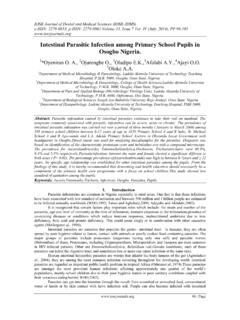Transcription of Treatment of Urinary Tract Infection - Internet
1 Treatment OF LOWER Urinary Tract Infection SUMMARY A three day course of trimethoprim 200mg bd is the agent of choice in uncomplicated UTI. Routine culture in uncomplicated UTI in women is unnecessary and expensive. Pregnancy is the only indication for treating asymptomatic bacteriuria. infections in males and children warrant further investigation. INTRODUCTION The Urinary Tract is the second commonest site of bacterial Infection and is a cause of significant morbidity both in terms of the number of people affected and the potential complications. Urinary Tract infections (UTI's) can be classified into complicated or uncomplicated UTI's.
2 An Infection is considered to be complicated if it affects pregnant women, children, men or the elderly or if it affects the upper Tract . Uncomplicated UTI's involve the lower Urinary Tract and encompass the syndrome of acute dysuria and frequency in otherwise healthy, non-pregnant women. Significant bacteriuria is generally regarded as cultured urine that yields a pure growth of organisms of greater than 105 colony forming units (CFU) per Sometimes a pure growth of >103 CFU/ml may be clinically important. The basis of management is the recognition that UTI's have vastly differing significance depending on the patients clinical picture, sex and age.
3 CAUSATIVE ORGANISMS AND DIAGNOSIS Most UTI's result from ascent of the organism into the bladder via the urethra. is the most commonly isolated organism. Others include Proteus mirabilis and Klebsiella species which may be quite resistant to antimicrobials. Staphylococcus saprophyticus can account for up to 10% of UTI's in sexually active ,3 The optimal way of dealing with UTI is to take a mid-stream specimen of urine and then commence an appropriate antibiotic. With the results of cultures and sensitivity and depending on the patients response, Treatment can be altered if necessary.
4 In practice, diagnosis is often made on the basis of typical signs and symptoms supported by a positive dipstick urinalysis for nitrites and leucocytes. UTI'S IN DIFFERENT PATIENT GROUPS Lower Tract symptoms are common in adult females. Approximately one half will have a bacterial cystitis. The differential diagnosis of the others include mainly the urethral syndrome and to a lesser extent, sexually transmitted disease or vaginitis. The urethral syndrome describes the syndrome of frequency and dysuria without A non-pregnant woman can be managed on the basis of a dipstick urinalysis.
5 If positive, a short course of a best guess antibiotic can be given. Symptoms may fail to resolve initially after Treatment but if they persist a urine culture or tests for other causes should be undertaken. Non-pregnant adult females with a negative dipstick and in whom the urethral syndrome is suspected may be advised on the need for a high fluid intake, regular and complete bladder emptying, good local hygiene and alkalinisation of the urine using potassium citrate mixtures. The only clear indication for Treatment of asymptomatic bacteriuria is during ,13 Many children with UTI, particularly neonatal males, have congenital structural All children, male and female should be referred for investigation following their first proven A prophylactic sugar-free antibiotic at low night-time dose should be continued until investigations are complete.
6 If reflux is present prophylaxis needs to be continued until spontaneous resolution, surgical correction or up to the age of 5 years. In subsequent infections of a normal Urinary Tract , short course chemotherapy can be used. UTI's are again a problem for males after the age of 50, when prostatic obstruction, urethral instrumentation and surgery influence the Infection rate. Infection at an earlier age in a male is rare and requires careful evaluation for the presence of Urinary Tract ,9 Bacteriuria occurs commonly in debilitated elderly patients particularly those in long-stay ,10 The reasons include the high prevalence of prostatitis in males, poor bladder emptying and faecal incontinence.
7 In elderly women, the loss of the oestrogen effect on the genito- Urinary mucosa can be a factor. Recurrent UTI's arise in many patients for various reasons which include gross anatomical abnormalities, development of resistance to the antibiotic used or a genetically predisposed uroepithelium. These patients need thorough investigation and may need antibiotic prophylaxis to prevent ,9 DURATION OF Treatment The traditional approach to Treatment of lower UTI was 7 to 14 days of therapy but studies suggest that shorter 3 day courses are as ,4,11,12 In the majority of women with symptoms indicating uncomplicated UTI, cure rates with 3 day therapy with trimethoprim appear comparable to those achieved with longer Single dose regimens amoxycillin 3g.
8 Fosfomycin 3g have been evaluated for the Treatment of uncomplicated UTI with varying cure rates (60-100%) reported. Further studies are required before they can be routinely For bacteriuria of pregnancy, a 7 day course of nitrofurantoin should be followed by a repeat urine culture to confirm clearing of the ,14 Longer courses of up to 4-6 weeks are recommended for women who relapse early with the same organism, for patients with diabetes, polycystic kidney disease and for renal transplant recipients, all of whom are more likely to have complicated Short course therapy should not be used for men, for patients with pyelonephritis.
9 Symptoms lasting more than seven days, anatomical or functional abnormalities of the Urinary Tract , immunosuppression or indwelling catheters or in those who have a high probability of having resistant In children, Treatment is usually given for seven days initially and may be followed by low dose prophylaxis until investigation of the Urinary Tract is CHOICE OF DRUG A renally excreted antibiotic with a long half-life, effective in short courses with a low incidence of side-effects is ideally required in the Treatment of UTI. Variation in antibiotic sensitivities exist between different areas and if a local antibiotic prescribing policy exists this should be adhered to.
10 The choice depends on the likely susceptibility of the organism, ease of administration, efficacy, freedom from adverse effects and relative cost. ANTI-FOLATES This group includes trimethoprim and co-trimoxazole. Trimethoprim is the agent of choice in non-pregnant women with an uncomplicated UTI. Long term use does not increase resistance, it has a convenient twice daily dosage regimen, is inexpensive and does not interact with the oral contraceptive pill (OCP). It can be used in children, except during the first six months of life and is used for Its main side-effects are skin reactions and gastrointestinal disturbances and it should not be used during Manufacturers recommend not to use during lactation although short-term use is not known to be harmful.
